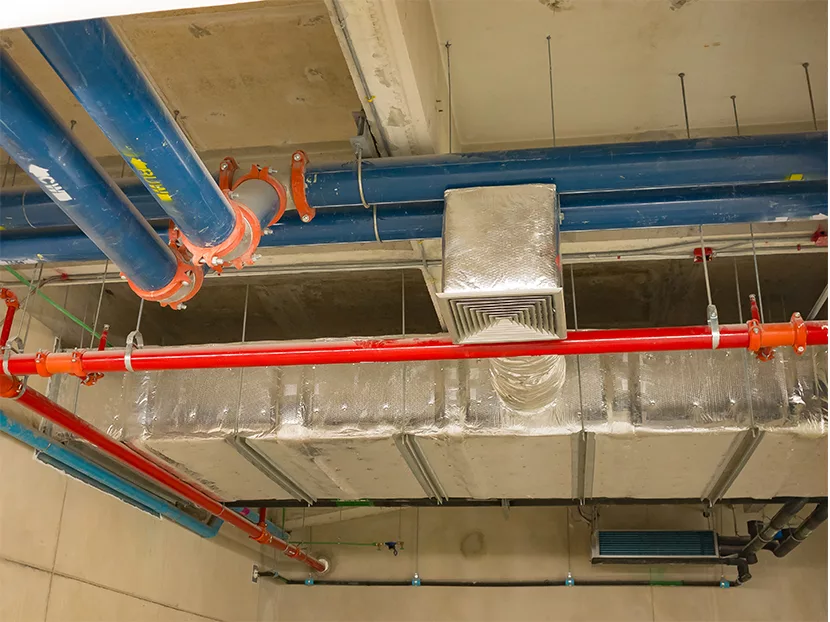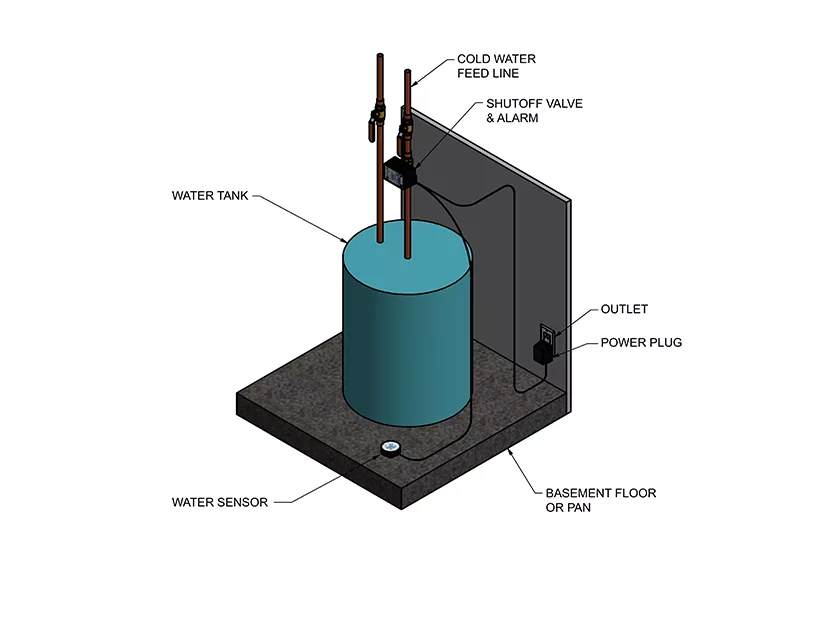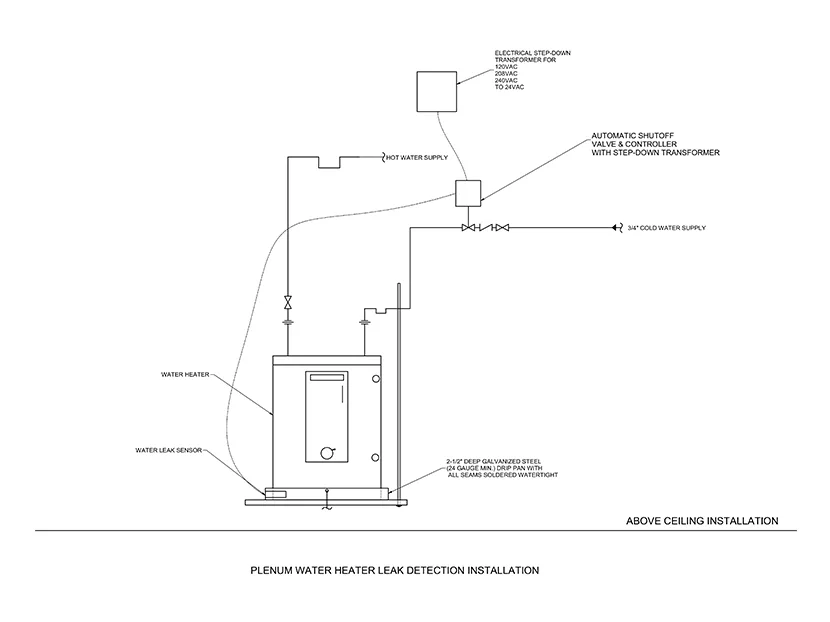Your design is sound, your contractors are experts and your equipment is top-notch. Why would your building be at risk for a plumbing leak?
Plumbing leaks contribute heavily to nearly $10 billion in homeowner insurance claims due to water damage each year, reports the Insurance Information Institute. And Zurich Insurance notes that water damage is the leading cause of property damage in offices, apartments and other real estate facilities.
Leaks are inevitable. They are not a reflection of design, quality or workmanship. Plumbing fixtures, joints and water-fed appliances are simply prone to failure over time. And when minor leaks go undetected for hours, days or even weeks, the resulting property damage can turn catastrophic — especially in common-risk commercial, residential or office buildings.
As water damage emerges as a leading source of claims, insurance companies are increasingly offering discounts for properties that employ plumbing leak detection, even mandating the installation of such systems if a claim has been paid out in the past or a property employs high-end finishes. Plumbing engineers and architects are driving adoption of leak detection as value-added engineering on their projects, and forward-thinking mechanical contractors and property owners are also helping to make plumbing leak detection a more mainstream technology.
A burst washing machine hose can release 650 gallons of water in a single hour. A plenum water heater can leak for days and no one will know until the ceiling collapses. Dishwasher leaks in residences and breakrooms can go undetected for weeks, causing mold issues in addition to water damage. In a commercial building left unattended over the weekend, a burst pipe can lead to ankle-deep water come Monday morning. Undetected slow leaks can lead to skyrocketing utility bills. Water can quickly spread and displace multiple tenants, damaging a building owner’s reputation and requiring them to deal with expensive insurance claims or even loss of coverage.
These are real problems your clients face every day; you are in a unique position to recommend proactive measures that can protect them.
The good news is that specifying leak detection technology does not have to be a frustrating or complex process. Solutions are available for even the most challenging spaces, from covering large facilities to monitoring within plenums.
Identify the risks
Leak detection is a simple concept, but it is by no means a one-size-fits-all deployment. The first step in choosing a solution for any given project is determining the potential leak risks in play.
What water-fed appliances and general plumbing layout do you need to monitor? Is protection needed for mission-critical equipment, data or priceless possessions? Are there tenant-related concerns that could lead to water-related problems, such as in a memory care or assisted-living facility? Are you dealing with a medical facility with many sinks or equipment using water filtration, such as dialysis machines? Is reducing water waste or consumption a critical concern to the building owner?
Once you’ve identified what you need to monitor, determining the desired outcome when a leak is detected is critical in specifying the best technology for the job. You should consider things such as: Who is using the water sources in question? What are the ramifications of shutting off the water supply? What is the potential impact of water damage mitigation activity on tenants, residents and building owners?
This information will help you determine what type of response you require from a leak detection system. Is a simple audible alarm sufficient to alert people of a leak? Or do you also need to automatically shut off the water supply to an individual appliance, entire office/apartment, floor, building section or even to the entire building? Is automatic notification of a leak required via text message, email or smartphone/tablet app? Do you need to tie in notifications to a building management or security system?
System design, operation and maintenance
After determining the desired outcome during a leak event, system design, operation and maintenance considerations will help you choose which product to specify. You’ve already identified the potential water shut-off points. Here are some of the other system-related considerations you should consider:
- For retrofit/refurbishment projects, is there access to the piping in the desired shut-off locations? Does the contractor have enough physical space to install the shut-off device in the desired location?
- Is electrical power required and available in the location?
- Do you need to account for plumbing or appliances located in plenum spaces?
- What pipe and valve sizes are you working with? You will find some mitigation systems offer limited valve size options.
- Valves must be rated for potable water (drinking water), adhering to both NSF/ANSI 61 and NSF/ANSI 372 to meet the federal Safe Drinking Water Act.
- Are battery-operated components acceptable to the client/tenant? Does easy access to such components exist to change the batteries?
- What happens to the system when it loses power? Will the valve automatically close and is it a positive or negative outcome for the client/tenant?
- How will the system be reset if the installation of the valve is behind the wall?
Point of contact vs. flow
Your final major consideration is the technology driving the system you specify, and you will usually encounter two options: point-of-contact or flow.
A point-of-contact system typically uses a conductivity sensor(s) to detect a leak. Sensors are deployed in areas where water is likely to first accumulate in the event of a leak — inside a pan or on the floor/surface. Water must come in contact with the sensor to activate the system, which may or may not include a valve to turn off the water feed automatically.
Point-of-contact technology can support a wide range of valve sizes and incorporate many different sensor types and accessories to accommodate a wide range of applications. Since sensors are deployed in specific locations, and wireless sensors are often addressable, it is typically easy to identify leak origination points. These systems do require that you do a good job predicting where water may accumulate, and more steps are involved in system installation than with flow monitoring solutions.
Depending on the facility, loss of unsecured sensors also can be a concern.
A flow monitoring system is installed directly on the water line. It constantly monitors usage, using preset triggers for volume (low, medium or high usage) or time (for example, 30 minutes of continuous flow before water is shut off), and it may or may not include a valve to turn off the water feed automatically. With no external sensors, flow technology is very discrete, and it can offer additional valuable data on overall water usage.
Flow systems are typically only available for 3/4-inch and 1-inch pipes. Installation can require significant feedline access, complete system drain-down and purge, and the like. The biggest challenge of using flow monitoring for leak detection is that it offers little indication of a leak’s origination point. False alarms also can occur from simple changes in behavior or usage patterns.
While plumbing leaks are a simple fact of life, the damage caused by them is almost completely preventable.
Building owners, tenants and industry forces are realizing the benefits of proactive leak detection and water damage mitigation systems — preventing business and homeowner disruption, property damage, additional claims from other needed remediation such as mold, loss of data and human life, and water conservation.
Leak detection specification is straightforward as long as you understand the desired outcomes, system design considerations and decision points.







